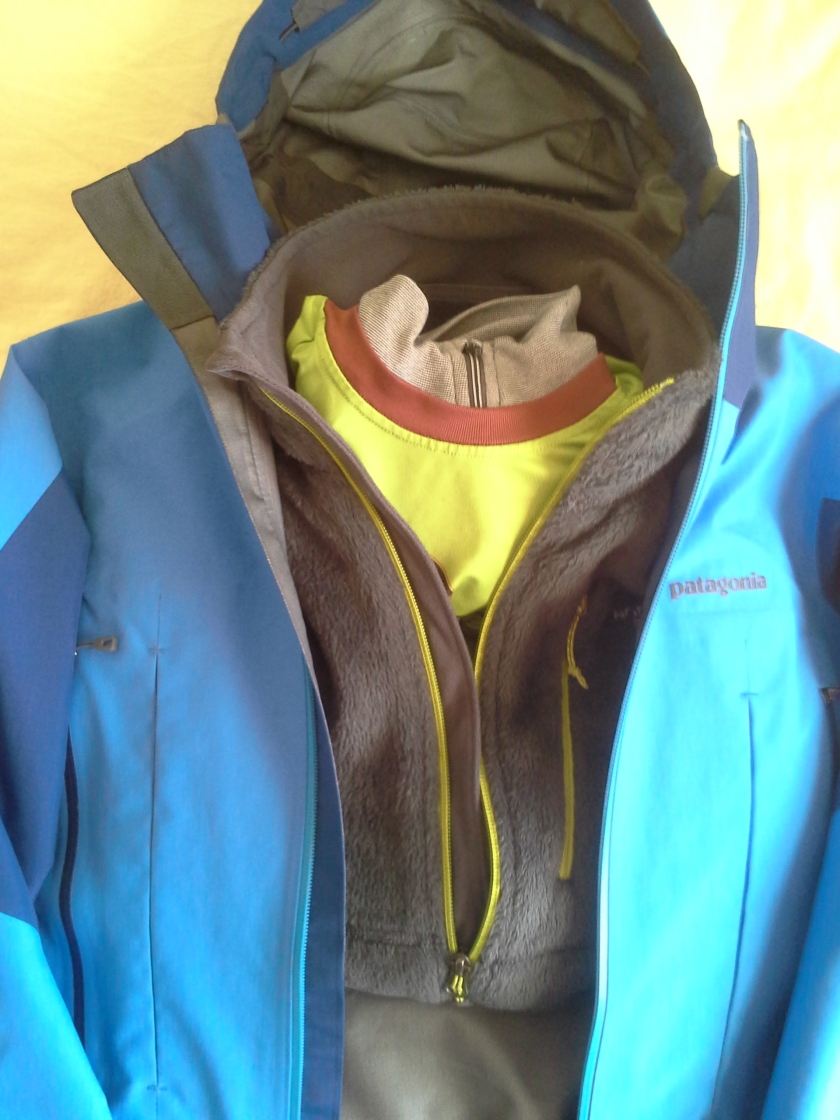
What I’m interested for this post is the waterproof/breathable (WP/BR) fabrics of two different jackets I own: Gore-Tex vs. eVent.
I’m actually not going to review the jackets, per se. What I will do is save you all from the fatal mistake I’ve made, an honest mistake that has ruined one of these two jackets.
Pictured above is my Showers Pass Elite 2.0 jacket, $250 retail. At the bottom you’ll find my Patagonia Super Alpine mountaineering jacket, $600 retail. Very different market segments, I know. The WP/BR laminate in the Patagonia is the high-end Gore-Tex Pro Shell, while that of the red, Showers Pass jacket is an unspecified, entry-level product from eVent. So, not apples and apples. I can’t offer up the definitive Gore-Tex vs. eVent head-to-head competition.
Or can I?
Both Gore-Tex and eVent fabrics are laminates, both using an active layer made of PTFE (polytetrafluoroethylene). The best known PTFE product is Teflon. The PTFE used in WP/BR fabrics is manufactured by stretching a PTFE solid to be a very thin, microporous membrane. The micropores are what make the membrane at once breathable yet waterproof. The micropores are too small to let in liquid water, such as rain or melted snow, yet large enough to allow moisture vapor to pass through, such as perspiration evaporating from your skin or baselayers.
The PTFE membrane must be protected from contamination. Contaminants such as skin oils and dirt will permanently clog unprotected micropores. Just how to protect the PTFE layer is where Gore-Tex and eVent part ways.
- Gore-Tex covers the PTFE membrane with a protective film of polyurethane (PU) on the interior side of the jacket.
- Rather than covering the whole PTFE membrane, eVent uses a proprietary method to somehow coat the interior of each micropore with an oil/dirt resistant chemical.
Wet System vs. Dry System
Gore-Tex is the so-called “wet system”: it vents perspiration only after vapor has collected as liquid on the inner surface of the jacket. As liquid, the moisture necessarily seeps through the PU film by basic diffusion, from the area of higher pressure (inside the jacket) to the area of lower pressure (the outside air). This diffusion forces the liquid water through the PTFE layer. So for Gore-Tex, venting is a two-step process: body moisture (vapor) must first condense on the inner surface. Only then can it diffuse through the membrane.
On the other hand, eVent is the “dry system”: sweat vapor vents “directly” through the membrane. It need not collect as liquid, first. In that sense, eVent is the “more breathable” of the two products. The two-step process of Gore-Tex venting definitely takes more time.
The problem with eVent—and this is essentially why I’m writing this post—is that its micropores are still vulnerable to contamination by skin oils and dirt. Yes, the micropores are treated with an oil- and dirt-resistant chemical. But get it dirty enough– i.e., clog the pores really badly—and the PTFE loses its breathability. Permanently.
Thus, eVent garments require laundering way more often than you’d think. We’re talking cycling garments, so, “regularly” means laundering after heavy use. Read: every, or every other, hard ride. If you ride through the winter, this means washing the jacket two or three times a week.
Washing it often isn’t a terrible hassle. But as everyone knows, washing machines are hard on clothes. So we’re caught between a rock and a hard place. Care for this jacket properly, and shorten its lifespan. Or, launder it less, and risk clogging the micropores.
In my ignorance, I managed to do both types of damage. First, I simply didn’t know of the need for regular laundering. I treated my Showers Pass jacket like a jacket. I washed it about once every four weeks. Micropores? Pretty damn, well clogged. Breathability went to near zero. When I learned of my mistake, I began washing the jacket weekly. Just one Wisconsin cold season meant laundering the jacket probably twenty times. Some of the breathability returned (though, mostly not). All the washing totally destroyed the DWR coating on the jacket exterior. Now the jacket no longer sheds water. Rain and snow don’t get through to the inside, blocked by the PTFE layer. But they do saturate the outer fabric of the jacket, sapping warmth.
Conclusion
I love my Patagonia jacket, while my Showers Pass jacket makes me sad. The Showers Pass jacket no longer performs. I’m pretty angry that the care tag didn’t alert me to the need for special care. I only learned of it on the web, after the damage was done. I wonder what percentage of eVent users know they should wash an eVent jacket as if it’s a sweatshirt? I also wonder, if laundered as often as necessary, will an eVent jacket survive even a single season?
On the other hand, I’ll be wearing my Patagonia jacket for years to come. It seems completely unfazed by three winters of serious abuse. And Gore-Tex requires no special care. So I won’t be laundering it to death.













